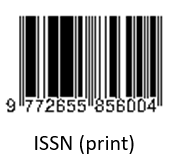Factors Influencing the Difficulty Level of the Subject: Machine Learning Technique Approaches
(1) Sanata Dharma University
(*) Corresponding Author
Abstract
The difficulty level of a subject is needed either to understand the student acceptance of the subject and the highest level of student achievement in it. Some factors are considered, what kind of instructions, the readiness of the instructor and students in teaching and learning, evaluation and monitoring systems, and student expectations. Many factors are involved, and educators should know this. It is better if they can discern which are the prime factors and which the secondary factors. The purpose of the study is to find out the determinant factors in establishing the difficulty level of the subject from the students, teachers and infrastructure point of view using three machine learning techniques. The MSE and the variable importance measurement were used to predict between some factors such as Attendance, Instructors, and other factors as independent variables and the difficulty level of the subject as a dependent variable. The study result showed that Gradient Boosting Machine obtained the MSE value result 1.14 and 1.30 for training and validation dataset. The model generated five variable importance as an independent factor, i.e. Attendance, Instructor, The course can give a new perspective to students, The quizzes, assignments, projects and exams contributed to helping the learning, and The Instructor was committed to the course and was understandable. The Gradient Boosting Machine is superior to other methods with the lowest MSE and MAE values results. Two methods, Gradient Boosting Machine and Deep Learning, have produced the same five main factors that influenced the difficulty of the subject. It means these factors are significant and should get intention by the stakeholders
Full Text:
PDFReferences
Maferima, T.a.A., F., How to Measure Motivation: A guide for Experimental Social Psychologist. Social and Personality Psychology Compass, 2014. 8/7: p. 328-341.
John, D., Katherine A. R., Elizabeth J. M., Mitchell J. N. and Daniel T. W., Improving Students Learning With Effective Learning Techniques: Promising Directions From Cognitive and Educational Psychology. Psychological Science in the Public Interest, 2013. 14(1): p. 4-58.
Hallinger, P. and J.F. Murphy, The Social Context of Effective Schools. 3, 1986. 94(3): p. 328-355.
Romero, C. and S. Ventura, Data mining in education. Wiley Interdisciplinary Reviews: Data Mining and Knowledge Discovery, 2013. 3(1): p. 12-27.
Vanthienen, J. and K. De Witte, Data Analytics Applications in Education. 2017: CRC Press.
Liao, S.N., et al., A Robust Machine Learning Technique to Predict Low-performing Students. ACM Transactions on Computing Education (TOCE), 2019. 19(3): p. 18.
Kushik, N., N. Yevtushenko, and T. Evtushenko, Novel machine learning technique for predicting teaching strategy effectiveness. International Journal of Information Management, 2016.
Cope, B. and M. Kalantzis, Big data comes to school: Implications for learning, assessment, and research. AERA Open, 2016. 2(2): p. 2332858416641907.
Gunduz, G. and E. Fokoue, Turkiye Student Evaluation I. University of California, School of Information and Computer Sciences, Editor. 2013.
Cabena, P., Hadjinian, P., Stadler, R., Verhees, J. and Zanasi, A., Discovering Data Mining: From Concept to Implementation 1998, Englewood Cliffs, NJ: Prentice Hall.
LeCun, Y., Y. Bengio, and G. Hinton, Deep learning. Nature, 2015. 521(7553): p. 436-444.
Liaw, A. and M. Wiener, Classification and regression by randomForest. R news, 2002. 2(3): p. 18-22.
Friedman, J.H., Greedy function approximation: a gradient boosting machine. Annals of statistics, 2001: p. 1189-1232.
Schapire, R.E., The boosting approach to machine learning: An overview, in Nonlinear estimation and classification. 2003, Springer. p. 149-171.
Kohavi, R. and F. Provost, Confusion matrix. Machine learning, 1998. 30(2-3): p. 271-274.
Ritschard, G., Computing and using the deviance with classification trees, in COMPSTAT 2006-Proceedings in Computational Statistics. 2006, Springer. p. 55-66.
Wei, P., Z. Lu, and J. Song, Variable importance analysis: A comprehensive review. Reliability Engineering & System Safety, 2015. Volume 142, October 2015: p. 399-432.
Grmping, U., Variable importance in regression models. Wiley Interdisciplinary Reviews: Computational Statistics, 2015. 7(2): p. 137-152.
Saa, A.A., Educational data mining & students performance prediction. International Journal of Advanced Computer Science and Applications, 2016. 7(5): p. 212-220.
Martin, F., C. Wang, and A. Sadaf, Student perception of helpfulness of facilitation strategies that enhance instructor presence, connectedness, engagement and learning in online courses. The Internet and Higher Education, 2018. 37: p. 52-65.
Henderson, C. and K.A. Harper, Quiz corrections: Improving learning by encouraging students to reflect on their mistakes. The physics teacher, 2009. 47(9): p. 581-586.
DOI: https://doi.org/10.24071/ijasst.v1i1.1869
Refbacks
- There are currently no refbacks.
Publisher : Faculty of Science and Technology
Society/Institution : Sanata Dharma University

This work is licensed under a Creative Commons Attribution 4.0 International License.











